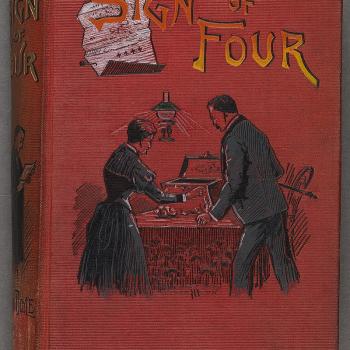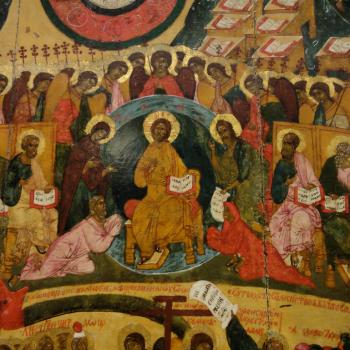Most significantly, Wheeler and Bennett confuse the story of St. Nicholas of Myra with the story of another historical Nicholas. The mix-up dates back to the tenth century when Symeon Metaphrastes (c. 912—c. 982/7) made an ill-fated decision while compiling stores about the saints. He noticed two men in the historical record with the name of St. Nicholas: St. Nicholas of Myra, who died around 335, and St. Nicholas of Sion, who died in 564. Although they had lived near each other geographically, they were separated by two hundred years in time. Even so, Symeon must have reckoned that one grand story would be more edifying than two miniature ones. Or, more charitably, maybe he was unsure how to keep the two lives separate. Or perhaps he did not recognize that they were different lives after all. The confusion of the two individuals must have been hard to avoid: modern archaeologists have found markers dedicating sites to osios Nicholas and hagios Nicholas. Both Greek words (osios and hagios) can be translated as "saint," but, in ancient times a subtle distinction was made between osios, which was used to describe ascetic and monastic saints like Nicholas of Sion, and hagios, used to describe martyrs, confessors, and churchmen like Nicholas of Myra.11 A monastic saint was osios, and a priestly saint was hagios. Surely not everyone who told and retold the tales of osios Nicholas and hagios Nicholas knew or observed those fine-toothed distinctions. Nor have scholars been able to do so until very recently. In the early 1980s, Ihor Ševčenko and Nancy Patterson Ševčenko performed the valuable task of reproducing and translating into English the one complete Greek copy of the Life of St. Nicholas of Sion, indisputably demonstrating that it is a completely different story from a different time.12 Not only have they made available a fascinating Life from late antiquity, they have shown that Nicholas of Sion is a distinct person from Nicholas of Myra. Symeon Metaphrastes either did not know or did not heed the important distinction between the two homonymous individuals. In consequence, he merged the two accounts and transmitted them as if they were one.13 The product, of course, was not a true Nicholas but a new Nicholas, a third Nicholas that was little more than an amalgamation of biographies. Unfortunately, Symeon's error stuck, and subsequent biographers like Wheeler and Bennett have simply repeated it. The result is that the true history of Nicholas of Myra remains muddled.
Notes
1. The icon is known as Agios Nikolaos o Streidas—St. Nicholas of the Oyster. Martin Ebon, Saint Nicholas: Life and Legend (New York: Harper & Row, 1975), 19.
. . .
6. Gerry Bowler, Santa Claus: A Biography (Toronto: McClelland & Stewart, 2005), 121-24.
7. Edward Clare, St. Nicholas: His Legends and Iconography (Florence: Leo S. Olschki, 1985), 22.
8. This image can be found in Clare, St. Nicholas, 23. Photograph by Kurt Weitzmann. Used with permission of the publisher.
9. Clare cites Otto Demus to say that less than 1 percent of all Byzantine art survived the Western crusade of 1204. Clare, St. Nicholas, 21.
10. Marianna Mayer, The Real Santa Claus (New York: Dial, 2001); Louise Carus, The Real St. Nicholas (Wheaton: Theosophical Publishing, 2002).
11. Gerardo Cioffari, "St. Nicholas: Documentary Evidence in Literature and Archeology," Bollettino di San Nicola 66, nos. 11 and 12 (1997): 12.
12. "Introduction," Ihor Ševčenko and Nancy Patterson Ševčenko, The Life of Saint Nicholas of Sion (Brookline: Hellenic College Press, 1984), 13.
13. Symeon Metaphrastes, Bios kai Politeia, in Patrologia Graeca, ed. J.-P. Migne (Paris, 1857-1866), 116:317-56.




